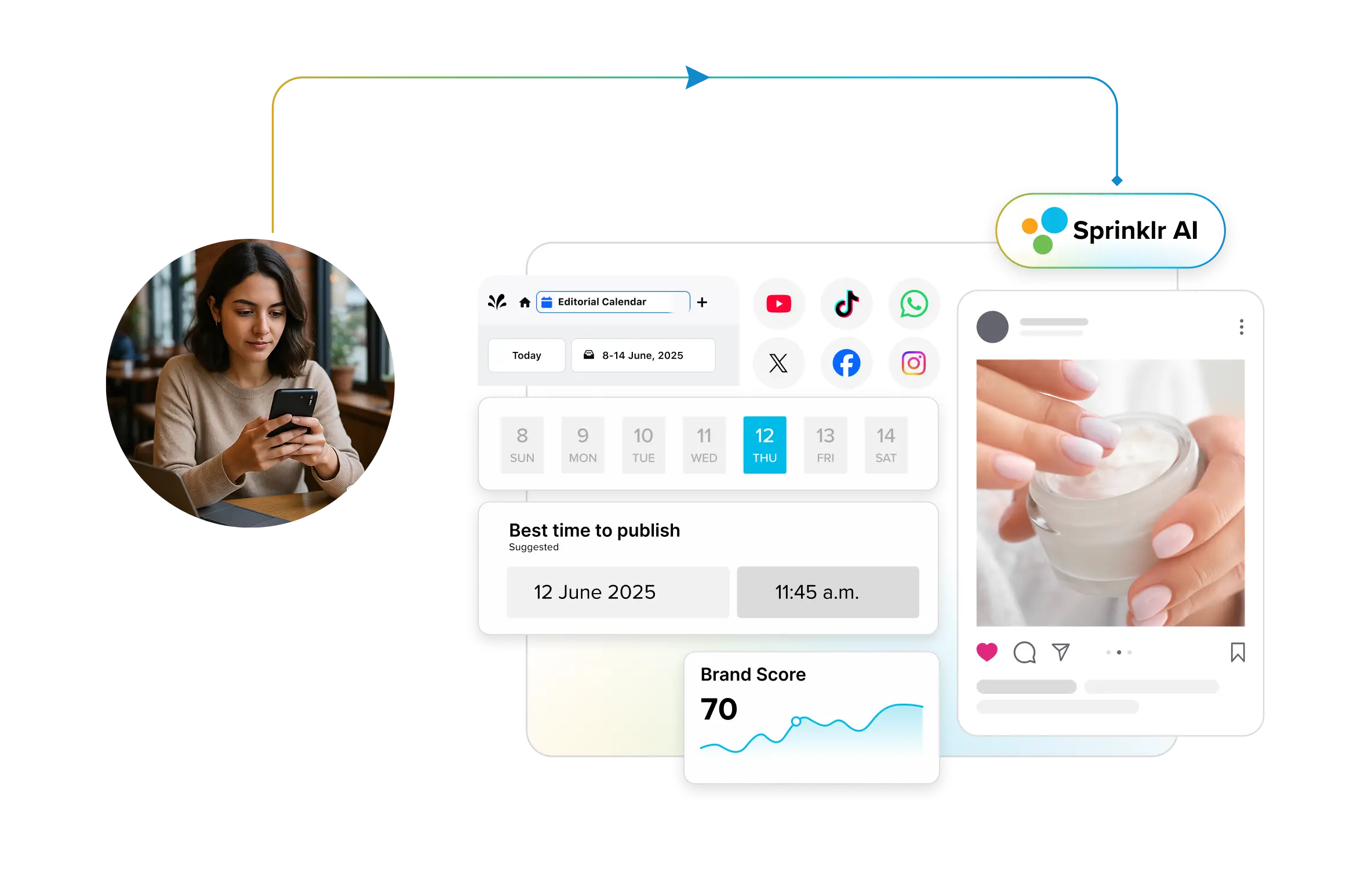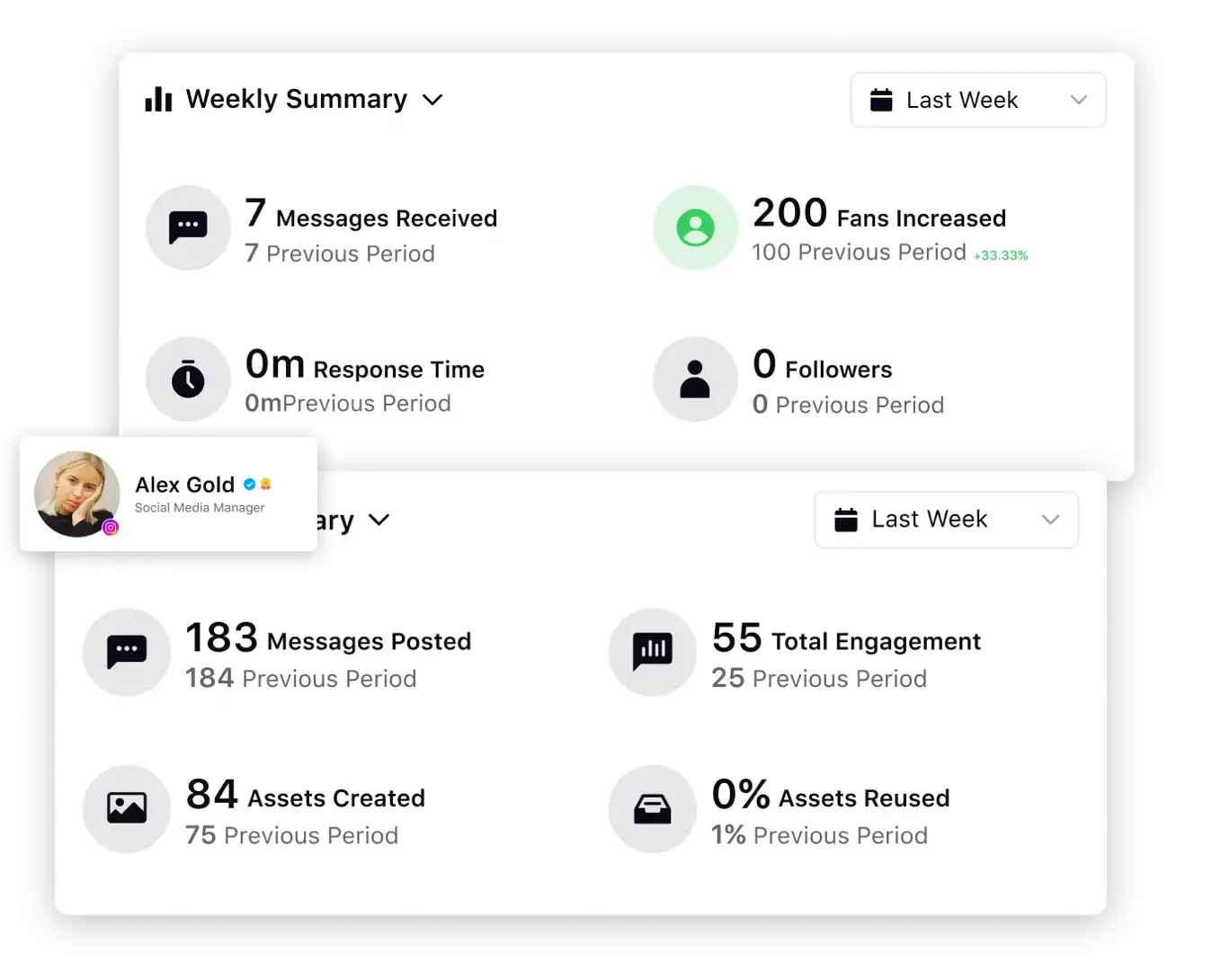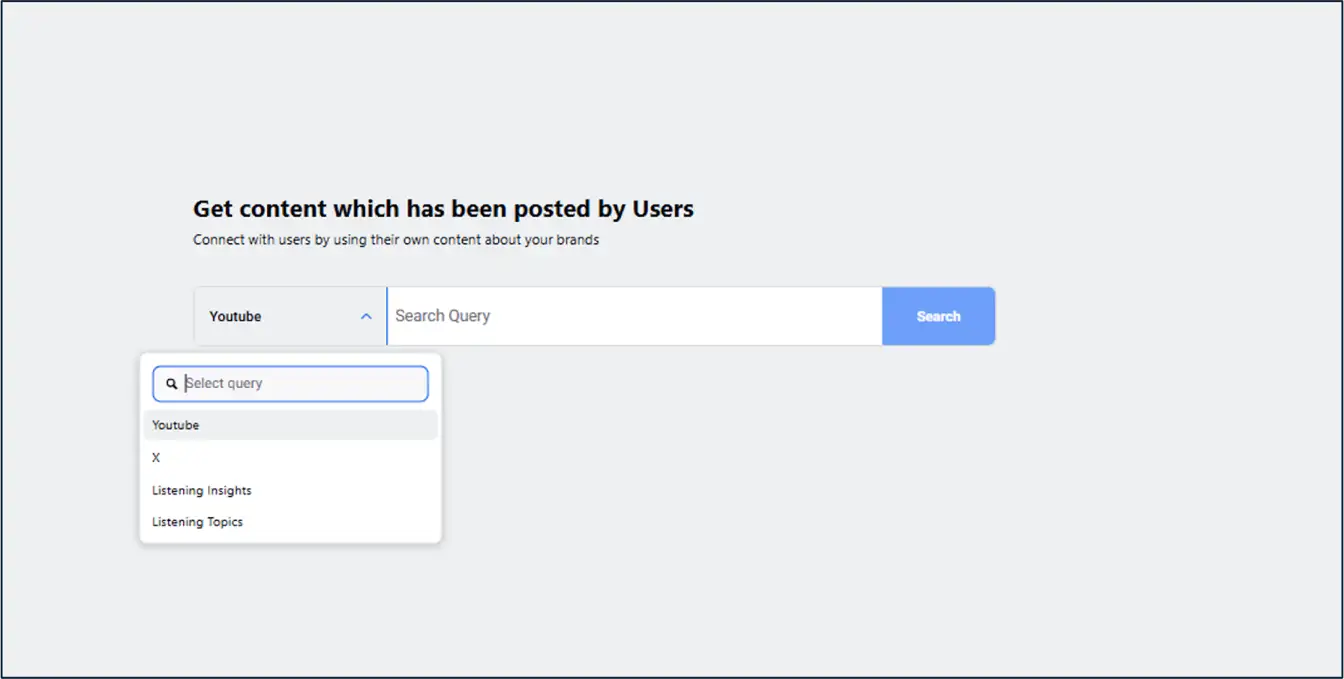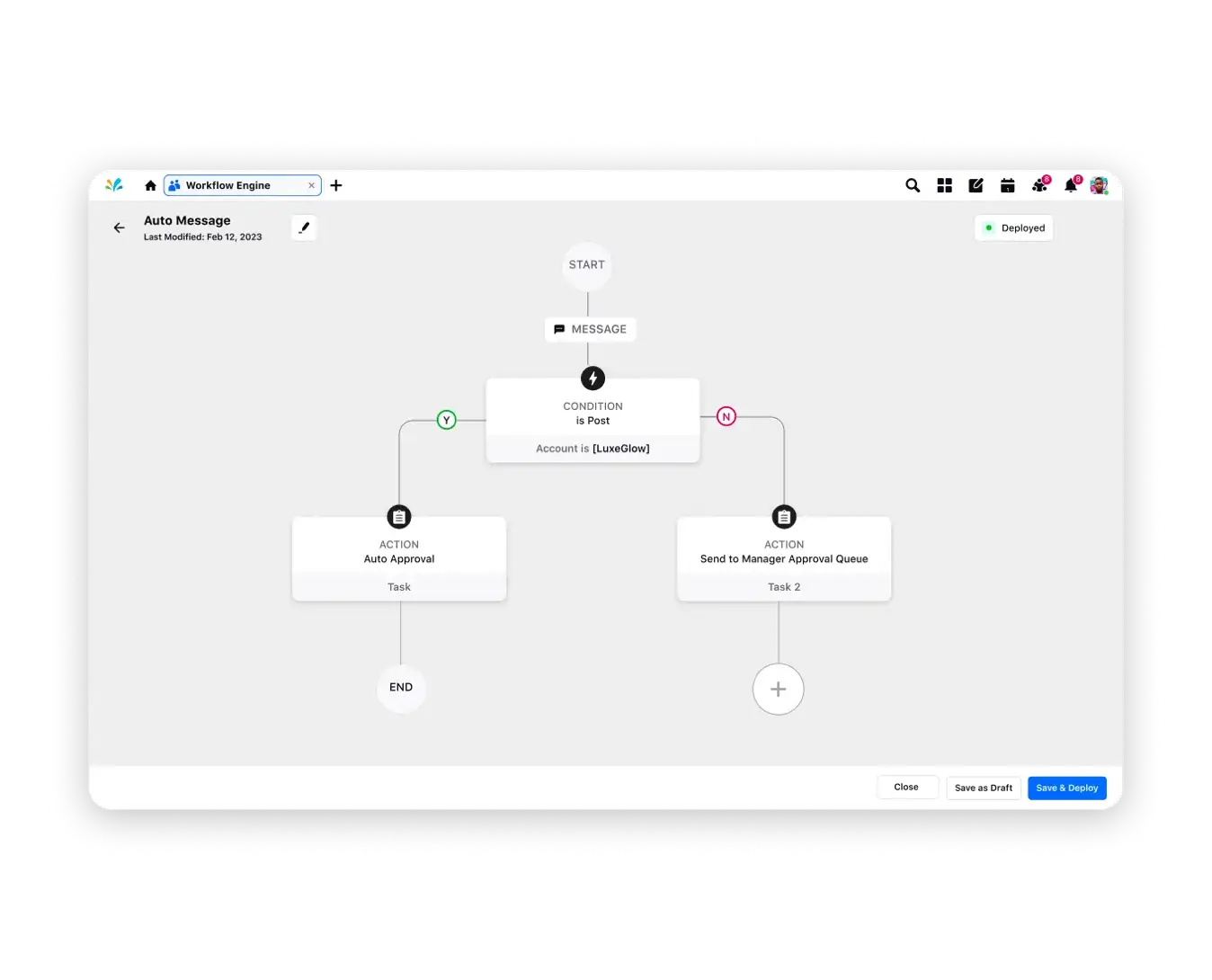The global leader in enterprise social media management
For over a decade, Sprinklr Social has helped the world’s biggest brands reimagine social media as a growth driver with a unified platform, industry-leading AI and enterprise-grade scale.

Social Selling: What It Is & How to Start
Enterprise buyers aren’t responding to cold outreach. They’re connecting on LinkedIn, engaging with relevant content, and starting conversations in DMs and comments. Sales teams that integrate social selling into their strategy are outperforming the rest. In fact, 78% of top-performing reps use social platforms and tools to build pipeline faster and close complex deals more efficiently.
This guide shows how B2B enterprises can scale social selling across teams and regions while staying compliant, consistent, and connected. You’ll get a practical framework to align sellers, content, and platforms, plus proven tactics to shorten sales cycles and earn buyer trust in 2025.
Traditional selling vs. social selling
Traditional and social selling are not competing strategies. They serve distinct purposes and excel at different phases of the buyer journey. The key distinction lies in how trust is built and when engagement begins.
Traditional selling is outbound-led, relying on high-volume tactics such as cold calls and mass email outreach to generate pipeline. While this approach offers speed and scalability, it often lacks context and struggles to surface truly qualified interest.
Social selling begins earlier in the journey. Sellers engage with prospects on platforms like LinkedIn, X, Instagram, Youtube and more by sharing relevant insights, responding to content, and building credibility before making direct contact. This trust-first approach helps uncover buyer intent sooner and opens access to multiple stakeholders within target accounts.
The real differences between traditional and social selling show up in execution. Traditional selling delivers consistency with predictable cadences, controlled messaging, and scalable processes across teams. But that efficiency often comes at a cost. Response rates are low, meeting costs are high, and without clear buyer signals, sales team struggles to prioritize accounts with real potential.
Social selling focuses on relevance, not volume. It drives higher conversions by engaging warm contacts and surfaces stronger intent signals for smarter targeting. To scale it effectively, teams need structured enablement, consistent coaching, clear governance, and measurable outcomes. Without this foundation, results are slow or inconsistent — especially in organizations still maturing their digital selling practices.
The most effective GTM teams align both approaches with their ideal customer profile, sales maturity, and available buyer intent data. Success depends on knowing when to prioritize scale and when to prioritize trust.
Why is social selling important in modern sales strategy?
The social selling process converts trust and relevance into sales outcomes. It turns credibility into closed deals through:
Identifying intent signals → engaging authentically → nurturing relationships → converting into sales.
For enterprise teams, this approach directly addresses the modern customer journey. Here’s how:
- Higher-quality opportunities from intent signals Social selling helps sales teams spot when buyers are ready to engage by using real-time signals like funding news, leadership changes, and hiring spikes. By monitoring these events through social listening on various social media platforms and industry updates, teams can reach out with timely, relevant messages. This approach lets them connect earlier in the buying process, focus on the most promising accounts, and close deals faster with a stronger pipeline.
- Marketing efficiency with leadership-level impact When paired with employee advocacy and targeted content, social selling reduces cost per lead while improving assisted conversions. At scale, this boosts KPIs leadership tracks most—brand trust, share of voice, customer lifetime value, and pipeline velocity.
- Cross-department value creation Social selling benefits more than just sales by creating value across the organization. It helps marketing expand reach and improve content ROI through relevant conversations. At the same time, customer experience teams gain deeper insights that enable better support and upsell opportunities. Product teams also benefit by collecting real-time market feedback that guides product development.
The urgency is real. Businesses that prioritize social selling are 51% more likely to reach their sales quota than those that don’t. If your teams aren’t visible and engaging online, your competitors likely are—winning the deals and relationships that could have been yours.
Social selling tactics by platforms
Success comes from matching your tactics to where your buyers spend their time and how they prefer to engage. A high-performing strategy blends platform-native features with authentic, value-led interactions.
For example, LinkedIn’s algorithm rewards expert commentary, Instagram thrives on visual storytelling and X amplifies real-time thought leadership. In each case, the goal is to spark conversations that feel organic, not transactional, while guiding prospects toward meaningful business outcomes.
Here is how each of the social selling platforms can help amplify social selling:
1. LinkedIn for B2B engagement
Suitable for: Enterprise B2B sales teams targeting decision-makers in tech, finance, SaaS, professional services and high-value consulting.
LinkedIn is the leading platform for B2B social selling, used by 96% of content marketers and enterprise GTM teams. It enables sellers to build trust and reach decision-makers through targeted, relationship-driven engagement. Tools like Sales Navigator help identify high-intent buyers with advanced filters. InMail boosts outreach effectiveness, delivering response rates up to three times higher than email. The Social Selling Index (SSI) tracks engagement and highlights areas for improvement. With the right LinkedIn marketing strategies, you can turn relevance into revenue.
The key opportunities for social selling on LinkedIn include:
- Optimizing for trust signals: Craft a headline that conveys your value proposition, use a banner that reflects your thought leadership and feature case studies or webinars to build authority before outreach.
- Leading with value in DMs: Reference shared connections or recent interactions to warm up conversations and mirror the recipient’s tone to avoid a scripted feel.
- Using Sales Navigator for precision: Filter by industry, role, or tech stack, and set alerts for trigger events like role changes or funding to engage at peak interest.
For example, Siemens Digital Industries Software needed to reach more global decision-makers and shorten lengthy sales cycles. By adopting LinkedIn Sales Navigator, they cut 3 to 6 weeks off their sales process and doubled their access to key stakeholders. The result: faster deals, stronger relationships, and a scalable, data-backed approach to enterprise selling.
The common pitfalls when scaling social selling in a B2B environment:
Social selling has proven to be effective, but when scaling, teams often over-automate outreach, leading to generic messaging that erodes trust. Maintaining social media personalization and relevance at volume requires structured enablement, shared content libraries and advanced social media analytics.
At an enterprise level, this also means addressing challenges like scaling personalization across global markets, AI-driven lead scoring for prioritizing high-intent accounts and governance frameworks for large, distributed sales teams to ensure compliance, consistency and brand integrity.
Pro Tip: Before sending a cold DM, build familiarity through consistent, value-driven comments on your prospect’s posts. This primes the relationship and positions you as a trusted name rather than an unsolicited message.
With a tool like Sprinklr’s Social Media Publishing platform, you can centrally track prospect activity across channels, identify engagement signals and coordinate comment-led outreach, ensuring every interaction is timely, relevant and backed by unified insights.

Book a demo to learn how Sprinklr helps you turn conversations into conversions.
2. Instagram and Facebook for consumer trust
Suitable for: B2C and DTC brands in beauty, fashion, wellness, home décor, food and beverage and other industries where visuals, lifestyle positioning and peer validation strongly influence purchase.
Social selling on Instagram and Facebook depends heavily on how their platform features support discovery, engagement, and conversion. Instagram’s visual-first layout supports lifestyle-led brands by allowing them to showcase products in real-life contexts. Shopping tags streamline the journey from browsing to purchase, while personalized feeds surface content to high-intent audiences.
Facebook adds scale through its connected ecosystem of Shops, Groups, Messenger, and targeted ads, giving brands a single environment to drive awareness, build community, and convert interest into action.
The key opportunities for social selling on Instagram and Facebook include:
- Building communities: Use Groups, brand challenges and active moderation to turn audiences into micro-communities and employer branding hubs.
- Leveraging interactive formats: Tap into formats like Polls, Reels, Stories, and Lives to expand reach and personalize brand perception through CSR stories, innovation showcases, and internal culture content.
- Collaborating with trusted creators: Partner with niche influencers or alumni to reach aligned audiences for customer and talent acquisition.
- Showcasing peer validation: Feature UGC and employee-generated content to strengthen trust and authenticity.
For example, Pleo, a smart business spending platform, used Facebook and Instagram to reach SMEs in new markets. In just three weeks, the campaign delivered a 5-point lift in ad recall, a 2-point boost in brand awareness, and strong engagement growth in key regions.
The common pitfalls when scaling social selling in consumer markets:
When scaling, brands often lean too heavily on influencer-driven campaigns without maintaining direct audience engagement. This erodes authenticity and reduces repeat purchase intent. To keep trust intact, pair creator partnerships with consistent brand-led community interaction and fresh, interactive content formats.
Pro Tip: Treat UGC as a conversion lever. For example, featuring a customer’s photo in your Story and tagging them boosts their loyalty and taps into their personal network, expanding your reach without ad spend.

Enterprise teams can take this further in Sprinklr, using unified dashboards to track UGC performance globally, AI governance to ensure compliance across markets, signal detection to identify prospect intent from UGC interactions and advanced attribution to link those engagements directly to pipeline and revenue impact.
Also read: Unlocking More From Your Sales Team: Social Selling for B2B Brands
3. X for thought leadership and visibility
Suitable for: Founders, consultants, executives and sales leaders in B2B, professional services, SaaS, fintech and any knowledge-led industry where authority and speed-to-insight drive pipeline.
X (formerly Twitter) has evolved into a real-time authority engine. B2B decision-makers use it to follow industry news, thought leaders and competitors. Its rapid, conversation-driven format makes it ideal for inserting your expertise into trending discussions and building visibility beyond your immediate network.
When used strategically, X can move you from “unknown” to “go-to voice” in your niche, often faster than content-heavy platforms.
The key opportunities for social selling on X include:
- Posting insights consistently: Share short, high-value takes on news, trends and pain points in a mix of text, threads and media to grow trust and followers
- Engaging in real time: Join trending conversations, reply to leaders and participate in Spaces to capture attention during peak moments
- Building thought-leadership threads: Break down complex ideas or case studies in multi-tweet threads and pin top performers for ongoing discovery
- Tracking prospects with Lists: Use curated Lists and search filters to find conversations around niche keywords or competitor mentions and monitor sentiment shifts
- Boosting visibility with native media: Share charts, videos and quote graphics during high-attention moments like announcements or earnings calls
For example, Mack Weldon, a men’s lifestyle brand, improved advertising efficiency using X’s Shopify integration. By linking their store to X Ads and using AI-powered targeting, they reached high-value urban men aged 30 to 60. Their holiday campaign delivered 3.1X return on ad spend and a low cost per 1,000 impressions of $1.90. This helped them acquire new customers effectively on X’s platform.
What are common pitfalls when scaling social selling on X?
Many users fall into the trap of chasing vanity metrics, likes, impressions and follower counts, without targeting the right audience. Without a clear niche and consistent positioning, visibility can be wide but shallow, leading to minimal sales impact. Stay disciplined in topic focus, audience targeting and call-to-action alignment.
Pro Tip: Treat X as a “visibility multiplier” for your longer-form content. Tease key points from a blog, webinar or LinkedIn article, then link to the full piece. This turns your X audience into a steady referral source for deeper engagement channels.
Enterprise teams can orchestrate these platform plays centrally in Sprinklr, ensuring brand consistency and measurable ROI.

Alt text: Sprinklr Rule Engine dashboard showing automated message routing, response management and approval workflows.
Book a demo to see how Sprinklr can automate social media management!
Modern blueprint of social selling success
To make social selling a revenue engine rather than an ad hoc activity, sales leaders need a repeatable, measurable execution model.
Below is a 4-pillar social selling guide, a cycle you can run consistently across B2B and B2C teams to build trust, influence decisions and drive conversions in 2025’s competitive market.
Pillar 1: Listen - social listening and opportunity mapping
Monitor industry conversations, buying signals, sentiment shifts, and competitor strategy to identify high-intent prospects before they raise their hand. Here’s how you can implement this:
- Use social listening tools to track keywords, hashtags and competitor mentions.
- Map opportunities with AI-powered opportunity mapping to spot pain points, product comparisons and funding or hiring news.
- Watch for trigger events like leadership changes, partnership announcements or market shifts.
Listening keeps you proactive rather than reactive; your team can enter conversations when trust is easiest to earn. For example, Sprinklr Social Listening can be used to alert sales reps when a target account’s CMO changes roles, triggering coordinated outreach across markets.
Pillar 2: Engage - Personal branding and thought leadership
Position your sales team as trusted industry experts that buyers look to for insight. Here's how to build credible, consistent personal brands across the organization:
- Empower reps to share original perspectives on industry news, market trends, and customer challenges. This builds trust and invites engagement.
- Align personal content with your brand narrative so every post reinforces your company’s message while allowing room for authentic voice.
- Maintain consistency in visuals, tone, and posting cadence to strengthen brand recognition and familiarity.
Modern buyers research the seller as much as the product; strong personal branding earns you a seat at the table faster. Such as Sprinklr governance can be used to approve LinkedIn posts in multiple languages, ensuring a consistent tone while allowing local market nuance.
Q&A: What types of content actually accelerate social selling?
High-performing formats include case study breakdowns, short-form video explainers, data-backed industry insights, customer success spotlights and how-to threads. Content that’s specific, timely and offers a clear takeaway drives the most engagement-to-conversion lift.
Pillar 3: Educate - Employee advocacy and content-ded prospecting
Scale your reach through authentic voices and valuable resources. Here’s how you can enable your team to educate prospects effectively:
- Enable team members to share curated, pre-approved content from a centralized library to keep messaging accurate and compliant.
- Use interactive formats like polls, Q&A posts, and webinars to spark conversations and engage audiences.
- Lead with education in direct messages by sending relevant reports, videos, or guides before asking for meetings.
When education precedes selling, you reduce friction and turn awareness into trust capital. For instance, Sprinklr’s advocacy module can be employed to push localized compliance-approved articles to advisors, driving a lift in inbound prospect messages.
Pillar 4: Convert - Insights-driven orchestration
Use data to time your outreach and tailor your message for maximum impact. Here’s how you can orchestrate precise social selling:
- Integrate CRM and AI-driven analytics to identify when prospects are most engaged and ready to act.
- Track content engagement, message open rates, and topic resonance to fine-tune campaigns in real time.
- Use multi-channel sequencing, including comments, direct messages, and emails, to follow up without being intrusive.
Conversion in social selling is about precision, not pressure to hit the right person, with the right message, at the right time. Here, Sprinklr’s integration with Salesforce can help trigger follow-up sequences only when decision-makers engage with key buying-stage content, cutting sales cycle time.
Q&A: What kind of buyer behaviors should I track to refine my social selling strategy?
Monitor post engagement patterns, profile visits, content shares, comment sentiment, inbound connection requests and DM response times. These behaviors reveal buying intent and content effectiveness so you can optimize your approach continuously.
Additional read: Social Selling Basics to Advance: A Complete Guide
Tools for managing social selling
Scaling social selling is all about creating a repeatable, measurable process that stays personal even as you grow. A unified CXM Platform help sales teams manage every step of the journey, from listening to conversion, without losing the human touch that makes social selling work.
Key features in a social selling management tool that make a difference:
- Unified social listening dashboard: Track industry keywords, brand mentions, competitor activity and sentiment trends across channels in one view. Large enterprises can coordinate team members across global markets while maintaining a single, compliant intelligence framework.
- AI-powered engagement insights: Leverage AI to analyze post-performance and engagement quality per market. Local teams get data-driven guidance on which content resonates, while AI compliance flagging ensures every interaction meets brand and regulatory standards.
- Content planning, governance and localization: Centralized scheduling and approval workflows ensure brand consistency across all geographies. Built-in language localization tools let regional teams personalize content while staying aligned with corporate governance rules.
- Integrated CRM and sales tools: Connect data with Salesforce, HubSpot or other enterprise CRMs to link every social touchpoint to pipeline forecasts and ROI reporting. This supports multi-market execution, full audit trails and measurable outcomes for leadership KPIs.
A platform like Sprinklr gives you all these features and more. Use it to transform social selling into a coordinated, insight-driven system that meets the governance, localization and compliance demands of global enterprises while enabling faster, higher-quality conversations in every market.
Q&A: Is there a way to A/B test voice or tone specifically for social selling success?
Yes, by segmenting audiences and posting different variations of the same message (tone, style or length) through Sprinklr, you can measure engagement and response patterns. Pairing these results with sentiment analysis helps identify which voice builds the most trust and drives the highest conversion rates.
Real social selling that moves the needle
When social selling is done right, it streamlines operations, builds trust and translates engagement into measurable business outcomes.
Case in point: Global Bakery
Operating in 30+ countries with dozens of brands, this global bakery wanted to cut through silos, unify its social presence and respond faster to customers, without adding headcount.
Here’s how they did it with Sprinklr:
- Unified social calendar: Centralized planning for every market and brand, ensuring consistent messaging and removing the chaos of disconnected tools.
- AI-powered customer care: Categorized 43M+ messages and saved 800 workdays in a year with automations like tagging and macros.
- Insight-led decision-making: Monitored sentiment, share of voice and competitor activity to guide campaign budgets and creative direction.
- Integrated workflows: Connected Sprinklr with Salesforce to turn high-value social interactions into service tickets instantly.
As a result, they achieved faster reporting (80% quicker), fully aligned teams across continents and a scalable playbook for both engagement and conversion, proving that with the right platform, social selling becomes a growth engine.
Wrapping Up
B2B leaders building authority on LinkedIn and X and B2C brands nurturing communities on Instagram and Facebook share one advantage when they tailor strategies to each platform: the ability to scale social selling with precision and impact.
Social selling has transformed how modern sales teams build trust and engage buyers by leveraging authentic, value-driven interactions on the platforms where prospects spend their time. By combining listening, engaging, educating and converting with the right tools such as Sprinklr Social and processes, you can turn social selling from a series of isolated tactics into a consistent revenue driver.
Frequently Asked Questions
Social selling uses social platforms to identify, engage and convert prospects via relationship and intent signals. Social media marketing focuses on brand reach and demand generation. Social selling is person-led and CRM-connected.
Run a 6-8 week cohort: profile clinics, platform tooling (Sales Navigator) plus Sprinklr orchestration, coached role-plays for comments and DMs and weekly measurement reviews with real pipeline attribution.
Primary: social-influenced pipeline, meetings booked from social, reply rate, content engagement rate among target accounts and conversion rate from social-sourced opportunities.
Yes. For B2C, it is discovery, community and conversion, such as shoppable content, UGC and DM-assisted sales. For B2B, it is relationship and intent-led prospecting. Both require different content and measurement frameworks.
Provide centralised playbooks, localised content libraries, role-based governance, measurement templates and a platform that enforces approvals while enabling distributed publishing.









